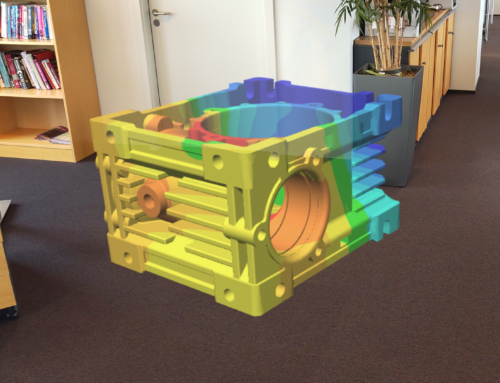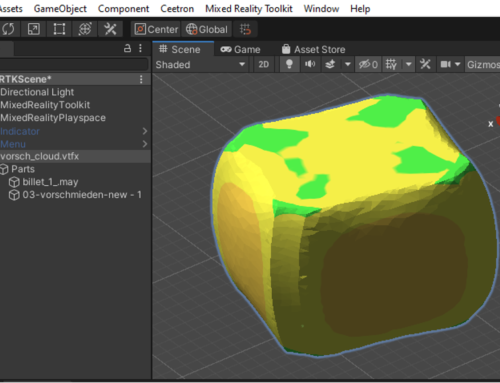How web-based 3D visualization will enable the cloudification of FEA/CFD software, and how that will transform today’s engineering workflows.
Why have computationally intensive engineering applications resisted cloudification?
The rapid migration of mainstream business functions into the cloud underscores the question. Finance, personnel, administration, productivity, and even many research applications are already up there. In fact, traditional on-premises IT is looking about as up-to-date as an abacus. Yet FEA and CFD applications remain stubbornly earthbound.
One hypothesis is that these applications are simply too big to work in the cloud. And to be sure, the model sizes for even moderate calculations like fracture propagation in 3D welds or vortex modelling for skyscrapers are very large. But we believe size is only one factor. A more complete hypothesis might look like this:
The increasing demand for collaborative manipulation and visualization of these massive models—in time and three-dimensional space, across geographies and organizational boundaries—has slowed the cloudification of FEA/CFD applications.
We think this cloudification is inevitable. But we also think it’s important to understand some of the subtleties of why it has not yet occurred. Below, we explore the issue in more depth with two members of the CAE and 3D visualization communities: Jon Hjelmervik, Research Manager at SINTEF; and Fredrik Viken, CTO at Ceetron, the industry partner in a joint research project on cloud-based visualization.
Q1: What were the motivations for SINTEF and Ceetron to pursue this joint project?
Jon: We saw that developments in graphics hardware and cloud computing could make advanced rendering methods available to the engineering community. To test those methods, we studied the potential of using both local and cloud computing resources for rendering scientific information, and for high-quality visualization with fully interactive response.
Fredrik: We wanted to be able to visualize models of any size on any device. The strategy we pursued was to do the rendering on the server (using its larger GPU/CPU and memory resources), and then stream the visualization as images or video to the client. Cloud-based visualization is strategically important for Ceetron going forward, and the CloudViz project has been an important study for us.
Q2: What solution hypotheses did you pursue, and what are your preliminary conclusions?
Jon: We believed that high-quality, interactive visualization could be achieved because: 1) we foresaw that we could develop efficient new algorithms and omit unnecessary conversions; and 2) technology had advanced to the point that web-based rendering of massive files was now practical. The projects results so far seem to confirm these hypotheses.
Fredrik: As I just mentioned, the solution uses server-side rendering and the streaming of images to the client. To hide latency, we used a simple proxy model. SINTEF did a great job with Tinia, and we successfully integrated the Ceetron rendering engine into Tinia.
[Tinia is a software development framework developed by SINTEF for the creation of OpenGL-based applications on portable devices using the limited GPU capacities of such devices in combination with the server’s high-end rendering hardware. It is currently in the research stage. Ed.]
Q3: What did you learn from this project?
Fredrik: The upside of the Tinia framework is that the model size only affects the server. The clients only show images/video, which require fewer computing resources. The downside is the latency and non-native feel of model navigation and animation playback, especially as we observed that the inherent latency caused model navigation to be slow/sluggish, with a variable frame rate. Today all clients, even mobile phones, have a very capable CPU/GPU combination, and somewhat at odds with the underlying architectural assumptions of Tinia, we believe that a solution that leverages the local GPU resources should give a better visualization experience.
Q4: This project happened as a host of new technologies were emerging. How will ultrafast GPU hardware, and web tools like WebGL, HTML5 and CSS3, contribute to the cloudification of 3D visualization?
Fredrik: WebGL is crucial. Prior to the WebGL standard, we used a plugin strategy, which today would be seen as at odds with current trends in corporate security standards, and IT regulations, and with the product strategies of all major browser providers.
WebGL supports advanced techniques to offload most rendering to the GPU without running client code. Using WebGL and JavaScript, one can effectively achieve almost the same performance, at least 90 percent, compared to a native application written in C++.
HTML5 and CSS3 have already allowed developers to create web applications that run almost as fast as those on the desktop (e.g., Microsoft Office, Google Docs). We foresee that in a few years, developers can use WebGL to create rich scientific visualization applications—including complete simulation environments with advanced 3D graphics—running in the browser.
Jon: Modern GPUs are not only faster than before, they’re much more flexible. WebGL makes them accessible through a 3D API that is supported on virtually all operating systems, and on devices ranging from workstations to mobile phones. HTML5 also provides ways to transport data that are optimized for communications among interactive web applications and the cloud infrastructure.
Q5: How will these technologies transform the way we collaborate on FEA and CFD models in the future?
Jon: Cloud technology not only makes the compute resources available, but also software and data. If you don’t have to download the whole model to interact with it, a whole new world of collaboration possibilities emerges.
Fredrik: I foresee that web-based 3D visualization will allow engineers to collaborate in real time, working on the same model while communicating using video and audio, by extending the functionality in WebEx/GoToMeeting today. This will challenge FEA and CFD developers to implement good collaboration platforms, but the software community have pondered these issues for many years in other areas. Take a look at what Apple has created in the latest Pages and Keynote.
Q6: What are typical use cases?
Jon: We think tailored workflows can be realized in a cloud environment. We’re studying this now in an EU project http://www.eu-cloudflow.eu/.
Fredrik: Typical use cases for these technologies would be distributed design reviews, simulation monitoring, result interpretation, and report generation.
Q7: Will future engineering applications work on pad-size devices in this environment?
Fredrik: I think pad-size devices and touch-based input is going to be more and more important. As a first step, I see pad-sized devices (or even smartphones) used for monitoring running analyses; collaborating on models that have already been setup and simulated; adding comments and annotations; simple parameter control; and simulation modification and restart.
In the future I see no reason why full-featured client applications for a touch-based screen of a limited size could not be successful. Pads have the performance, with big GPUs that can render several million textured triangles at 30 FPS. The main challenge will be memory. Today, pads have a lot less RAM than desktop systems. But they’ll get more, while the need for RAM will be reduced by the emergence of cloud-based systems. In short, it will be possible to create rich user experiences on these devices, but it will require deep thinking and new ways of designing user interfaces.
Q8: Let’s talk numbers: What are typical model sizes today, and what will they be in 10 years?
Fredrik: The typical range today is between 10 and 50 million nodes on unstructured mesh topologies, one magnitude bigger on structured mesh topologies. In 10 years this number could increase by a factor of 100. The reason is twofold: First, model sizes grow in lockstep with the capability to simulate and post-process the data; people always want the biggest possible model to get the most accurate results. Second, a cloud-based architecture lets you rent almost unlimited computing power for a reasonable price. The only remaining constraint on model size is therefore the ability to post-process and interpret the results. This is why enabling in-cloud visualization and result interpretation is so important. Building and buying desktops to do work of this scale is no longer practical.
Q9: What do you see as key technical requirements for cloud-based engineering software to be attractive for end users?
Jon: Users expect cloud-based software to be intuitive and easy to use. At the same time, they want access to the functionality they’re used to. Providing seamless transitions among applications, and a high degree of interactivity, will be the most challenging technical requirements to meet.
Q10: What other technologies are missing for the cloudification of engineering software?
Jon: CAD software requires a very high degree of interactivity to design and modify the models. This is still very challenging for cloud-based visualization.
Fredrik: One of the main hurdles for cloud-based engineering software is security. Models and simulation results are valuable IP and must be protected, so a solid security solution is imperative. It is also important to offer such software on both private/corporate cloud systems and on their commercial analogs (e.g., Amazon EC2, Microsoft Azure, etc.)
Another hurdle is communication. Scientific simulations consume and create large data volumes. The bandwidth needed to transfer this data has become a limiting factor. Hence the need for a fully cloud-based solution where data is generated and stored in the cloud. In Ceetron’s 3D Components, more than 90 percent of the data generated on the server stays on the server; a tremendous reduction in the need for bandwidth.
Q11: Are there commercial vendors in this space that offers cloud-based engineering software, whether based on your technologies or alternative technologies?
Fredrik: Several major vendors appear to be investing significant money in this area. Apple enabled WebGL in iOS 8, and Microsoft was very late to the party with Internet Explorer. Their implementations are still a bit buggy and will improve over time. But I have not yet seen a mature cloud-based offering. WebGL is still in its infancy and, in my mind, a key requirement for building a comprehensive cloud-based FEA/CFD solution. To my knowledge, existing CAE vendors who have cloud-based offerings use an image/video streaming approach for visualization rather than real 3D models combined with local rendering using WebGL in the client.
Q12: What is the business case for SaaS for CAE vendors?
Jon: We have found that some potential CAE users, especially SMEs, are discouraged due to obstacles like upfront licensing, installation/maintenance costs, and the need to purchase expensive computational resources. SINTEF believes that affordable, easy-to-use solutions, with little requirements for local resources, can win these new customers with a pay-per-use strategy.
Fredrik: I think SaaS will be increasingly important for CAE vendors. It will enable a completely new category of customers that cannot afford/justify the cost of buying a CAE software system, but can afford to rent it on a case-by-case basis. It also enables the “freemium” pricing strategy that has been so successful in other areas (e.g., Apple’s App Store).
Q13: And the business case for SaaS for end users / end user IT departments?
Jon: A cloud-based solution can either replace local infrastructure, or be used as an add-on for peak time periods, when required capacity exceeds local capacity. Either way, end users get a better solution at a lower price.
Fredrik: SaaS gives end users an opportunity to use advanced software without paying a huge price up front. It also simplifies maintenance, as these solutions are often web-based, and thus automatically hosted and updated by the vendor. The IT department’s responsibility in this process is to ensure end user computers run the appropriate browsers.
Q14: A final question: How will SINTEF and Ceetron commercialize these technologies, as either products or research? What are your roadmaps?
Jon: SINTEF has already published some results in international journals and conference proceedings. In 2015 we will present related research both at the top European computer graphics conference (Eurographics) and in the top journal of visualization (tvcg). SINTEF will also commercialize the technology through partnership with industrial partners. Several EU projects have invited us to join, one of which aims to provide a commercial platform after project end date in 2017.
Fredrik: Cloud-based 3D visualization is strategically important for Ceetron. Ceetron has recently initiated a three-year project supported by three of our key industrial partners that will take cloud-based 3D visualization technology to production quality. Our long-term goal is to offer our 3D Components platform on a WebGL/JavaScript platform so that our users can create browser-based, 3D visualization applications using HTML5/CSS3.
Project Results will be made available as they are produced. Later this year, we will release our “One-Click-Sharing” offering, which will extend our free 3D viewer offering and make it extremely easy to share interactive 3D engineering models directly from one’s simulation environment to anyone with a modern web browser.
+ + +
Thanks to Jon and Fredrik for volunteering their insights and perspectives in the form of this virtual discussion. On a general note, this is the first blog in a series of blogs at the intersection of CAE and 3D visualization, some addressing high-level industry issues, some digging deep into the technology. In future blogs, we will examine more closely some of the more technical issues that this discussion explores. We welcome input from members of the CAE and 3D visualization communities regarding the blog, including suggestions for topics we should cover. Target publication frequency will be once every 14 days, but we will prioritize quality thinking and novel insights over frequency.
Grim
+ + +
About Fredrik Viken, CTO in Ceetron: Fredrik holds a M.Sc. in computer science. He has been with Ceetron for his more than 15-year career as software developer and technical expert in 3D visualization.
About Jon Hjelmervik, research manager of the research group for heterogeneous computing at SINTEF: Jon holds a Ph.D. from the University of Oslo and INP Grenoble in France, where he studied advanced use of modern GPUs and CPUs. He was the project manager of the CloudViz project referred to above, and is now leading the system design group of CloudFlow, a European research project that aspires to making cloud technology available for the manufacturing industry.









Leave A Comment
You must be logged in to post a comment.